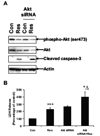Resveratrol downregulates PI3K/Akt/mTOR signaling pathways in human U251 glioma cells
- PMID: 19827268
- PMCID: PMC2833270
Resveratrol downregulates PI3K/Akt/mTOR signaling pathways in human U251 glioma cells
Abstract
Resveratrol (trans-3,4', 5-trihydroxystilbene) is a naturally occurring polyphenolic compound that has antiinflammatory, antioxidant, neuroprotective properties and acts as a chemopreventive agent. Resveratrol causes cell cycle arrest and induces apoptotic cell death in various types of cancer cells. In the current studies, the effect of resveratrol on phosphoinositide kinase-3 (PI3K)/protein kinase B (Akt)/mammalian target of rapamycin (mTOR) signaling pathway was examined in human U251 glioma cells. Resveratrol decreased both the expression and phosphorylation of Akt. Inhibitors of PI3K (LY294002) and Akt (SH-6) enhanced resveratrol-induced LDH release and caspase-3 activation. Resveratrol reduced phosphorylation of ribosomal protein S6 and the mTOR inhibitor rapamycin further enhanced resveratrol-induced cell death. These results suggest that the downregulation of PI3K/Akt/mTOR signaling pathways may be an important mediator in resveratrol-induced apoptosis in glioma cells.
Figures




References
-
- Kondo Y, Hollingsworth EF, Kondo S. Molecular targeting for malignant gliomas (Review) Int J Oncol. 2004;24:1101–1109. - PubMed
-
- Lassman AB. Molecular biology of gliomas. Curr Neurol Neurosci Rep. 2004;4:228–233. - PubMed
-
- Aggarwal BB, Bhardwaj A, Aggarwal RS, Seeram NP, Shishodia S, Takada Y. Role of resveratrol in prevention and therapy of cancer: preclinical and clinical studies. Anticancer Res. 2004;24:2783–2840. - PubMed
-
- Das S, Das DK. Anti-inflammatory responses of resveratrol. Inflamm Allergy Drug Targets. 2007;6:168–173. - PubMed
-
- Jang M, Cai L, Udeani GO, Slowing KV, Thomas CF, Beecher CW, Fong HH, Farnsworth NR, Kinghorn AD, Mehta RG, Moon RC, Pezzuto JM. Cancer chemopreventive activity of resveratrol, a natural product derived from grapes. Science. 1997;275:218–220. - PubMed
Publication types
MeSH terms
Substances
Grants and funding
LinkOut - more resources
Full Text Sources
Research Materials
Miscellaneous
